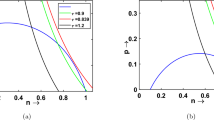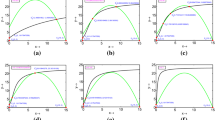Abstract
Cooperation among species is a ubiquitous behavior to better understand the system dynamics from an ecological perspective. Hunting cooperation among predators can impose fear effects on the prey population, thereby decreasing the prey’s birth rate. Considering this fact, we propose a model that incorporates hunting cooperation among predators and the fear-induced birth reduction in the prey population. We have done the complete dynamical analysis, including boundedness of solutions, persistence of the system, existence of all equilibria and their local and global stability, existence of Hopf bifurcation and its direction and stability, and existence of saddle-node bifurcation. We analyze Hopf bifurcation with respect to the hunting cooperation parameter and saddle-node bifurcation by varying the predation rate. Moreover, we analyze the multi-stability of the system and observe that bi-stability occurs in two different scenarios. In the spatially extended system, we provide a detailed stability analysis and obtain the conditions for Turing instability. Various Turing patterns such as spots, holes, and stripes are obtained and discussed the biological significance of these patterns for the two-dimensional spatial model. We performed numerical simulations to validate our analytical results for both spatial and non-spatial models.
















Similar content being viewed by others
Data Availability Statement
This manuscript has associated data in a data repository. [Authors comment: The data that support the findings of this study are available within the article.]
References
M.T. Alves, F.M. Hilker, Hunting cooperation and Allee effects in predators. J. Theor. Biol. 419, 13–22 (2017)
L. Berec, Impacts of foraging facilitation among predators on predator–prey dynamics. Bull. Math. Biol. 72(1), 94–121 (2010)
C. Boesch, Cooperative hunting in wild chimpanzees. Anim. Behav. 48(3), 653–667 (1994)
S. Creel, D. Christianson, Relationships between direct predation and risk effects. Trends Ecol. Evol. 23(4), 194–201 (2008)
S. Creel, N.M. Creel, Communal hunting and pack size in African wild dogs, Lycaon pictus. Anim. Behav. 50(5), 1325–1339 (1995)
W. Cresswell, Predation in bird populations. J. Ornithol. 152(1), 251–263 (2011)
S. Djilali, C. Cattani, Patterns of a superdiffusive consumer-resource model with hunting cooperation functional response. Chaos Solitons Fractals 151, 111258 (2021)
B. Dubey, B. Das, J. Hussain, A predator–prey interaction model with self and cross-diffusion. Ecol. Model. 141(1–3), 67–76 (2001)
B. Dubey, N. Kumari, R.K. Upadhyay, Spatiotemporal pattern formation in a diffusive predator-prey system: an analytical approach. J. Appl. Math. Comput. 31(1), 413–432 (2009)
D.P. Hector, Cooperative hunting and its relationship to foraging success and prey size in an avian predator. J. Ethol. 73(3), 247–257 (1986)
C.S. Holling, Some characteristics of simple types of predation and parasitism1. Can. Entomol. 91(7), 385–398 (1959)
V. Kumar, N. Kumari, Bifurcation study and pattern formation analysis of a tritrophic food chain model with group defense and Ivlev-like nonmonotonic functional response. Chaos Solitons Fractals 147, 110964 (2021)
S.A. Levin, L.A. Segel, Hypothesis for origin of planktonic patchiness. Nature 259(5545), 659–659 (1976)
S.L. Lima, Nonlethal effects in the ecology of predator–prey interactions. Bioscience 48(1), 25–34 (1998)
J. Liu, B. Liu, P. Lv, T. Zhang, An eco-epidemiological model with fear effect and hunting cooperation. Chaos Solitons Fractals 142, 110494 (2021)
A.B. Medvinsky, S.V. Petrovskii, I.A. Tikhonova, H. Malchow, B.-L. Li, Spatiotemporal complexity of plankton and fish dynamics. SIAM Rev. Soc. Ind. Appl. Math. 44(3), 311–370 (2002)
K. Nitu, M. Nishith, Positive solutions and pattern formation in a diffusive tritrophic system with Crowley-martin functional response. Nonlinear Dyn. 100(1), 763–784 (2020)
A. Okubo, S.A. Levin, Diffusion and Ecological Problems: Modern Perspectives, vol. 14 (Springer, New York, 2001)
C. Packer, D. Scheel, A.E. Pusey, Why lions form groups: food is not enough. Am. Nat. 136(1), 1–19 (1990)
S. Pal, N. Pal, S. Samanta, J. Chattopadhyay, Effect of hunting cooperation and fear in a predator–prey model. Ecol. Complex. 39, 100770 (2019)
S. Pal, N. Pal, S. Samanta, J. Chattopadhyay, Fear effect in prey and hunting cooperation among predators in a Leslie–Gower model. Math. Biosci. Eng. 16(5), 5146–5179 (2019)
R.D. Parshad, N. Kumari, A.R. Kasimov, H.A. Abderrahmane, Turing patterns and long-time behavior in a three-species food-chain model. Math. Biosci. 254, 83–102 (2014)
L. Perko, Differential Equations and Dynamical Systems (Springler, New York, 2001)
L. Pribylova, A. Peniaskova, Foraging facilitation among predators and its impact on the stability of predator–prey dynamics. Ecol. Complex. 29, 30–39 (2017)
S.K. Sasmal, Population dynamics with multiple Allee effects induced by fear factors-a mathematical study on prey–predator interactions. Appl. Math. Model. 64, 1–14 (2018)
S.K. Sasmal, J. Banerjee, Y. Takeuchi, Dynamics and spatio-temporal patterns in a prey–predator system with aposematic prey. Math. Biosci. Eng. 16(5), 3864–3884 (2019)
S.K. Sasmal, Y. Takeuchi, Dynamics of a predator-prey system with fear and group defense. J. Math. Anal. Appl. 481(1), 123471 (2020)
S.K. Sasmal, Y. Takeuchi, Modeling the Allee effects induced by cost of predation fear and its carry-over effects. J. Math. Anal. Appl. 505(2), 125485 (2022)
L.A. Segel, J.L. Jackson, Dissipative structure: an explanation and an ecological example. J. Theor. Biol. 37(3), 545–559 (1972)
A.M. Turing, The chemical basis of morphogenesis. Philos. Trans. R. Soc. Lond. B Biol. Sci. 237(641), 37–72 (1952)
R.K. Upadhyay, N. Kumari, V. Rai, Wave of chaos in a diffusive system: generating realistic patterns of patchiness in plankton-fish dynamics. Chaos Solitons Fractals 40(1), 262–276 (2009)
R.K. Upadhyay, N.K. Thakur, B. Dubey, Nonlinear non-equilibrium pattern formation in a spatial aquatic system: effect of fish predation. J. Biol. Syst. 18(01), 129–159 (2010)
R.K. Upadhyay, W. Wang, N.K. Thakur, Spatiotemporal dynamics in a spatial plankton system. Math. Model. Nat. Phenom. 5(5), 102–122 (2010)
X. Wang, L. Zanette, X. Zou, Modelling the fear effect in predator–prey interactions. J. Math. Biol. 73(5), 1179–1204 (2016)
X. Wang, X. Zou, Modeling the fear effect in predator–prey interactions with adaptive avoidance of predators. Bull. Math. Biol. 79(6), 1325–1359 (2017)
R. Yang, J. Wei, Bifurcation analysis of a diffusive predator-prey system with nonconstant death rate and Holling III functional response. Chaos Solitons Fractals 70, 1–13 (2015)
L.Y. Zanette, A.F. White, M.C. Allen, M. Clinchy, Perceived predation risk reduces the number of offspring songbirds produce per year. Science 334(6061), 1398–1401 (2011)
Acknowledgements
The authors are grateful to the anonymous referees for the critical review and constructive comments that enhanced the quality of the manuscript. Author Anshu acknowledges the Research Fellowship received from UGC, New Delhi, India.
Author information
Authors and Affiliations
Corresponding author
Appendix
Appendix
1.1 Proof of Theorem 8
Proof
To find the stability and direction of Hopf bifurcation, we calculate the first Lyapunov coefficient. Let \(u = x -x^*\) and \(v = y-y^*\), then system (2) becomes
Now, expanding the above system in Taylor’s series at \((u,v)=(0,0)\) up to third order, we get
\(f_1(u,v)\) and \(g_1(u,v)\) are the higher-order terms of u and v, given by
where
and
System (18) can be written as
where
Now, Hopf bifurcation occurs when \(Tr(J_{E_1^*})=0\) and \(det(J_{E_1^*})>0\), i.e., at the Hopf bifurcation point, the eigenvalue will be purely imaginary, which is given by \(i\sqrt{f_ug_v-f_vg_u}\). Eigenvector corresponding to this eigenvalue \(i\sqrt{f_ug_v-f_vg_u}\) is given by \({\overline{v}} = \Big (f_v, i\sqrt{f_ug_v-f_vg_u}-f_u\Big )^T\). Now, we define \(S = \Big (Re({\overline{v}}), - Im({\overline{v}})\Big ) = \left[ \begin{array}{cc} f_v &{} 0 \\ -f_u &{} -\sqrt{f_ug_v-f_vg_u} \end{array} \right] .\) Now, let \(U = SZ\) or \(Z = S^{-1}U\), where \(Z = \Big (z_1,z_2\Big )^T\). Therefore, under this transformation, the system is reduced to
This can be written as
where \(H_1(z_1,z_2)\) and \(H_2(z_1,z_2)\) are given by
The direction of Hopf bifurcation is determined by the sign of the first Lyapunov coefficient, which is given by
\(\square \)
Rights and permissions
About this article
Cite this article
Sasmal, S.K., Anshu & Dubey, B. Diffusive patterns in a predator–prey system with fear and hunting cooperation. Eur. Phys. J. Plus 137, 281 (2022). https://doi.org/10.1140/epjp/s13360-022-02497-x
Received:
Accepted:
Published:
DOI: https://doi.org/10.1140/epjp/s13360-022-02497-x




